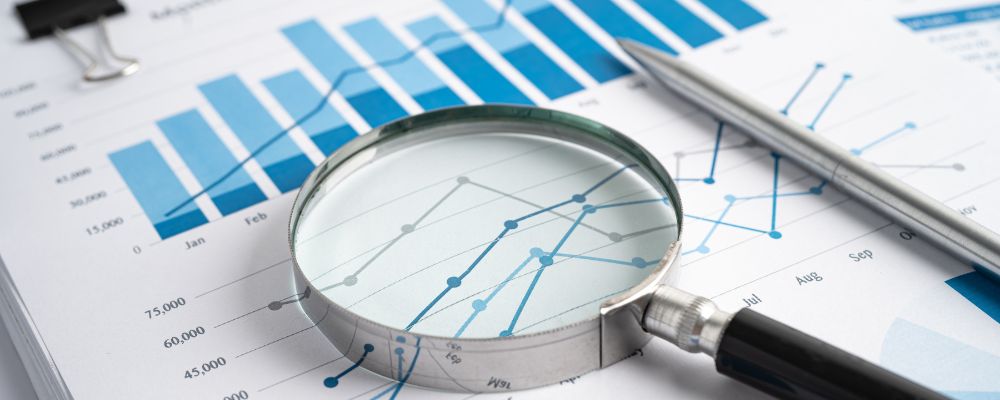Financial ratios are measurable statistics that are used to evaluate a company’s overall functioning and financial performance. These are calculated using statistics derived from a company’s financial statements, such as income statements, cash flow statements, and balance sheets. These ratios can be used to compare a company’s performance with that of its competitors and with its own previous-year performance. Along with this, it is also used to evaluate the whole risk that comes with investing in a business.
Where Are Financial Ratios Used?

Financial ratios are used by different entities for various purposes in different situations. But these are commonly used by investors and businesses.
Investors: Financial ratios are used by investors to analyse whether to invest in stocks and businesses. They are able to assess the risk, profitability, future potential, and financial health of a company by comparing various ratios. It helps them determine whether a specific business matches well with their investing objectives or not.
Businesses: Financial ratios are also used by businesses to evaluate their own performance and monitor their progress over time. They can analyse their effectiveness, set financial targets, and pinpoint areas that need work. They can use financial ratios as a basis for their budgeting, resource allocation, and overall financial strategy.
Types of Financial Ratios
These are different types of financial ratios that a company uses, and each of these ratios has its own significance and importance. These are ratios that are calculated by using specific data from a company’s financial statements. These different types of financial ratios are grouped into five main categories.
1. Liquidity Ratios

Liquidity ratios have been used to measure a company’s ability to pay off its short-term liabilities. Liquidity ratios show how quickly a company can turn its assets into cash and use them to pay off its debt. If a company has a higher liquidity ratio, it becomes easier for it to pay off the dues and avoid going into payment failure.
A. Current Ratio
The current ratio, also known as the work-capital ratio, is measured as the potential of a business to fulfil its duties in the upcoming 12 months. It can be easily acquired by dividing the current assets by the current liabilities.
Current Ratio = Current Assets / Current Liabilities
B. Quick Ratio
A quick ratio is used to find out whether a company has a good amount of liquid assets so that they can be easily converted into cash to pay off immediate debts. To find out the quick ratio, you need to divide the liquid current assets, which include cash, marketable securities, and accounts receivable, by the current liabilities.
Quick Ratio = (Cash + Marketable securities + Accounts receivable) / Current liabilities
C. Cash Ratio
The cash ratio is used to determine the financial state of a company in terms of cash. This is done by checking that a company can pay off its liabilities by completely relying on liquid assets, such as marketable securities and cash and cash equivalents. This ratio can be calculated by dividing the cash and cash equivalents by current liabilities.
Cash Ratio = Cash and Cash equivalents / Current Liabilities
2. Profitability Ratios

This ratio provides a company with relevant results regarding its financial performance at the end of each accounting year, which can be used to make better decisions afterwards. Profitability ratios are used to measure the potential capability of a business to generate profit in terms of sales, operating costs, balance sheet, and equity. The greater the ratio, the more advantageous it is to the company since it indicates that it can continually generate a profit.
A. Margin Ratios
Margin ratios are the financial metrics that are used to evaluate the profitability of a company in relation to sales. These ratios help a company find out how effectively it manages and controls its expenses.
i. Gross Profit Margin
A gross profit ratio is a type of profitability ratio that is used to measure a company’s revenue as compared to its gross margin. This ratio is used to highlight the profit that the company has earned after settling its cost of goods sold. (COGS).
Gross profit margin can be simply calculated by deducting direct costs and the cost of goods sold (COGS) from gross sales. Gross sales are calculated by subtracting gross revenue from allowances, discounts, and returns. After this, you need to divide the obtained number by net revenue and then multiply the resultant figure by 100%.
Gross Profit Margin = (Gross Profit / Net Sales) x 100
ii. Net Profit Ratio
A net profit ratio is a profitability ratio that is used to measure the company’s profit relative to the total amount of income generated by the company. The higher the net profit ratio, the more beneficial it is for a company since it helps the company keep its expenses under control.
This ratio is also referred to as net margin profit ratio. To calculate it, one needs to subtract the total expenses from the total revenue.
Net Profit Ratio = Net Income / Revenue
iii. Operating Profit Margin
The operating profit margin is used to evaluate a company’s profit on sales after settlement for production’s variable expenses, such as salaries and goods, but before you pay taxes or interest. To keep track of how a company is using its resources, you can simply look into your operating profit margin.
Calculating the operating profit margin is done by deducting the selling and product costs and expenditures for general and administrative purposes (also known as operating expenses) from the net sales. and after that, divide the obtained number by net sales, then multiply by 100%.
Operating Profit Margin = (Operating Income / Net Sales) x 100
B. Return Ratios
Return ratios are the ratios that are used by a company to check how much profit is made on its investments. These ratios help in tracking the amount of money a company earns from its investors and shareholders.
i. Return on Equity (ROE)
Return on equity is used to evaluate a company’s profitability and efficiency in terms of how well it produces its profits. ROE is also known as return on net assets since, to calculate the owner’s equity, you simply have to subtract debt from assets.
To calculate return on equity (ROE), you just have to divide net income by shareholders’ equity. If the ROE is higher, then the company is more effectively using its equity capital to generate revenue and expand the business.
Return on Equity = Net Income / Shareholder’s Equity
ii. Return on Assets (ROA)
Return on assets (ROA) is a profitability ratio that is mainly used to evaluate a company’s profit on the basis of its total assets. This ratio is used to show the entire financial condition of a company since the funds that the company is investing in assets are compared to its net profit.
To calculate the return on assets ratio, start by dividing the company’s net income by that of its total assets. A higher return on ROA indicates that the management is more productive and efficient in using the resources.
Return on Assets = Net Income / Total Assets
iii. Return on Invested Capital (ROIC)
The return on invested capital is used to measure the efficiency with which a company distributes its funds to profitable operations. To ensure that the capital invested in the business is efficiently used, many companies compare their weighted average cost of capital (WACC) to their ROIC.
ROIC mainly highlights how effectively a business can generate profit from its capital. To calculate ROIC, you need to take invested capital and then divide it by net operating profit after tax (NOPAT). ROIC is presented as a percentage.
Return on Invested Capital (ROIC) = Net Operating Profit After Tax (NOPAT) / Invested Capital
3. Leverage ratios

The leverage ratio is one of the most significant financial ratios because it tells you how much of the company’s capital exists in debt. This ratio is also used to evaluate the company’s ability to fulfil its obligations. The leverage ratio has become an important part of financial ratios since it examines the company’s capital structure and its capacity to control its financial structure and settle its debts. Additionally, a leverage ratio is used for evaluating a business’s operating expenses and to figure out how adjustments to output may impact operating profits.
A. Capital Structure Ratio
The capital structure ratio is used to decide on the funding strategy of a business that is employed to enable the business to concentrate on long-term solvency.
i. Equity Ratio
The equity ratio is a financial ratio that evaluates how much leverage a business uses. This ratio uses asset investments and the total amount of equity to find out how effectively a business handles its debt and finances its asset needs. If there is a low equity ratio, then the company mainly focuses on its debts to buy assets, and this is considered a sign of increased financial risk.
If the company has a high equity ratio, then it indicates that it has good assets and that its liabilities are comparatively low. The equity ratio is calculated by dividing the total amount of shareholders’ equity by the total assets.
Equity Ratio = Total Equity / Total Assets
ii. Debt Ratio
A debt ratio is a type of financial ratio that is used to calculate the level of leverage that a business has. If the debt ratio is higher, then it indicates that the company has borrowed more debt than it can actually repay, which indicates that the company’s liabilities exceed its assets.
In addition to this, it also signifies that the business is in danger of defaulting on loans if interest rates are suddenly increased. If this ratio is less than one, then it indicates that the company has more assets as compared to its debts. To calculate the debt ratio, you just need to divide the total debts by the total assets.
Debt Ratio = Total Debt / Total Assets
iii. Debt To Equity Ratio
The debt-to-equity (D/E) ratio is used to check the amount of debt a company has as compared to its assets. In corporate finance, the D/E ratio is considered a very crucial indicator that checks how much a business depends on debt to finance its operations as compared to its own resources.
When a firm has a high debt-to-equity ratio, it is borrowing more money from the market to support its operations. Whereas, when the ratio is low, the company is making use of its assets and borrowing less money from the market. The debt-to-equity ratio is calculated by taking the total liabilities of a business and dividing them by the shareholder’s funds.
Debt To Equity Ratio = Total Debt / Shareholders Fund
Or
Debt To Equity Ratio = Total Liabilities / Total Shareholders Equity
B. Coverage Ratio
Coverage ratios are used to measure a company’s capacity to fulfil its financial obligations, which include dividends or interest payments. The higher the coverage ratio, the easier it is for a company to completely pay off its interest and dividends.
i. Debt Service Coverage Ratio
The debt-service coverage ratio (DSCR) is used to calculate the cash flow of a company so that it can pay off its current debts. This ratio helps investors as well as lenders check whether the company has sufficient funds to pay down its debts.
If a DSCR is high, then it is always considered that the company is strong, whereas if this ratio is low, then the company is facing some financial issues. To calculate this ratio, you need to divide net operating income by debt services, which also include interest and principal.
Debt service coverage ratio = Operating Income / Total debt service
ii. Interest coverage ratio
The interest coverage ratio is a debt and profitability ratio that is used to measure whether a business can easily pay interest on its outstanding debts or not. This ratio is also known as the time interest earned (TIE). This method of financial ratio is mainly used by creditors, investors, and lenders.
They use this method to determine a company’s risk in relation to its outstanding debt and the future borrowings that the company will make. This ratio is calculated by simply dividing the earnings before interest and taxes (EBIT) by the interest expenses of a company during a specific period of time.
Interest coverage ratio = Operating income / Interest expense
iii. Cash Coverage Ratio
The cash coverage ratio is a ratio that is used to check the potential of an organisation to pay expenses incurred on interest using the cash balance that the company has. A company to pay off its interest expenses out of cash only.
It is considered a good sign if the company has a higher cash coverage ratio since it becomes easier for a company to pay off its interest expenses on its debts and also to pay off dividends. It is very simple to calculate the cash coverage ratio since you just need to divide the total cash by the interest expenses.
Cash coverage ratio = Total cash / Total interest expense
4. Efficiency Ratios

The efficiency ratio is used to check the utilisation of assets and liabilities that a company uses internally. This ratio is an effective way to calculate the receivables, the repayment of dues, the amount of equity used, and, along with this, the overall use of investments and equipment. In addition to this, it is also used to monitor and analyse the overall growth of investments and commercial banks.
A. Inventory Turnover Ratio
The inventory turnover ratio, also referred to as the stock turnover ratio, is used to check whether the inventory is efficiently managed. The ratio is used to evaluate the excessive inventory that a company holds as compared to sales. If the ratio is high, then it indicates that inadequate inventory is disturbing the overall company’s revenue.
Whereas a low inventory turnover indicates that there may be a large number of orders that help support initiatives to reduce expenses, this ratio is calculated as the cost of goods divided by the average inventory balance for that particular accounting year.
Inventory Turnover Ratio = Cost of Goods Sold / Average Inventory
B. Asset turnover ratio
The asset turnover ratio is used to evaluate the efficiency of a company, and along with this, it checks how much it uses its assets to produce sales. This ratio is evaluated by checking with the competitors; if the ratio is high, then the company is functioning more efficiently.
Whereas if the asset turnover ratio is low, then the company has poor utilisation of fixed assets. The asset turnover ratio is calculated by just dividing net sales by the average total assets.
Asset Turnover Ratio = Net Sales / Total Assets
C. Accounts Receivables turnover ratio
The accounts receivable turnover ratio is used to check the number of times a company collects its average accounts receivable balance. This ratio is measured in a manner in which it uses its line of credit processes and collects the previous dues from the customers.
If the accounts receivable turnover ratio is high, it means the company is ineffective in various aspects. This ratio is calculated by just dividing net sales by average account receivables.
Accounts Receivables turnover ratio = Net Sales / Average Account Receivables
5. Market Prospect Ratios

The market prospect ratio is a very important financial ratio for investors since it helps them to predict the returns on investments. Along with this, the profits may be expressed as an increase in the stock value and dividends in the future. This helps the investors to calculate the future stock price and along with them, the dividends may also be expected to earn.
A. Earnings Per Share (EPS)
Earnings per share is the amount of a company’s income that gets divided among all the outstanding shares of the common stocks available in the company, and this amount is also made available to shareholders. EPS is also referred to as the worth of a company.
If the EPS of a company is high, then the company is gaining profit, and it would be advised to increase the dividend payout over time. To calculate EPS, net income is subtracted from the preferred income. After that, the obtained number is divided by outstanding common shares.
Earnings Per Share = (Net Income – Preferred Dividends) / Outstanding Shares
B. Price-to-Earnings Ratio
This ratio gives the investor an idea of the real value of a company. It depicts the relationship between the stock price of a company and its earnings per share (EPS). If the price-earning ratio is high, then it means that the stock is expensive and the prices may fall anytime in the future. This ratio is calculated by dividing the market price of the shares by the earnings per share.
Price Earning Ratio = Market Price / Earnings Per Share
C. Dividend Payout Ratio
The dividend payout ratio is an essential financial ratio that is used to check the company’s ability to pay dividends and to check the overall financial health of a company. This ratio is also called the payoff ratio since this amount is used to pay off debts or reinvest in the operations of a business.
If the DPR is high, then it indicates that the company is paying a large amount of earnings as dividends and reinvesting less into the company. To calculate DPR, you need to divide the dividend per share by the earnings per share. Dividend per share is calculated by dividing the total number of dividends received by a company by the total number of shares owned by the company.
Dividend Payout Ratio = Dividend Per Share / Total Number of Dividends
D. Dividend Yield Ratio
The dividend yield ratio is a ratio that is used to calculate the amount of cash flow a company is getting for each rupee that it has invested in the stock market. The dividend yield ratio is highly used by investors who predict that there will be a consistent increase in capital and dividends in the long term.
If this ratio is high, then the company is distributing a large amount of profits to its shareholders. To calculate this ratio, you just need to divide the dividend per share by the market value per share. And to calculate the dividend per share, you need to divide the total number of dividends received by a company by the total number of shares owned by the company.
Dividend Yield Ratio = Dividend Per Share/Market Value Per Share
Wrapping Up
Financial ratios are a very strong tool that is used to convert complex financial data into meaningful information that can be effectively used by a company. By analysing these five ratios, a company can easily gain in-depth knowledge of the advantages and disadvantages and the potential outcomes that it has to overcome. To get a complete view of the company, the ratios should be calculated using industry standards, long-term trends, and the company’s business plans.
Frequently Asked Questions
There are a total of 5 financial ratios, which include liquidity ratios, profitability ratios, leverage ratios, efficiency ratios, and market prospect ratios.
The five financial ratios are used to determine the performance of a company in terms of its financial health. By analysing these different financial ratios, investors, creditors, and other stakeholders can easily learn important information on the financial health of a company. Along with this, it comes to knowing about the company’s future growth and its risk-bearing capacity.
Since their ratios are quite confusing to memorise, you write them down easily and group them as per their use and purpose.
Liquidity can be defined as a company’s efficiency in converting assets or securities into cash without affecting its market price.
Profitability ratios are also known as return on investments.
The two types of leverage ratios are the capital structure ratio and the coverage ratio.
